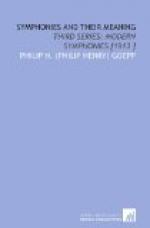A final conclusive line is given by the solo flute. Besides the constant course of varying tune, there is a power of ever changing harmony that seems to lie in some themes.
[Music: Modere (Viola solo) Tres simplement]
One can hardly call it all a Scherzo. It is rather an idyll after the pathos of the Andante. Or, from another view, reversing the usual order, we may find the quality of traditional Trio in the first melody and a bacchanale of wild humor in the middle. For, out
[Music: Tres anime (Woodwind and strings)]
of a chance phrase of horns grows of all the symphony the boldest harmonic phrase (repeated through ten bars). Above rings a barbarous cry, in defiance of common time and rhythm.
Suddenly we are surprised by the sound of the martial stride of the second theme of the Andante which moves on the sea of rough harmony as on a native element. One whim follows another. The same motion is all there, but as if in shadow, in softest sound, and without the jar of discord; then comes the fiercest clash of all, and now a gayest dance of the first tune, assez vif, in triple rhythm, various figures having their pas seul. A second episode returns, brilliant in high pace but purged of the former war of sounds. At the end is the song of the first tune, with new pranks and sallies.
The beginning of the Finale is all in a musing review of past thoughts. The shadow of the last tune lingers, in slower pace; the ominous dirge of first motto sounds below; the soothing melody of the Andante sings a verse. In solemn fugue the original motto is reared from its timid phrase to masterful utterance, with splendid stride. Or
[Music: Modere et solennel (Cellos and basses)]
rather the theme is blended of the first two phrases, merging their opposite characters in the new mood of resolution. The strings prepare for the sonorous entrance of woodwind and horns. One of the greatest fugal episodes of symphonies, it is yet a mere prelude to the real movement, where the light theme is drawn from a phrase of latest cadence. And the dim hue of minor which began the symphony, and all overspread the prelude, at last yields to the clear major. There is something of the struggle of shadow and light of the great third symphony of Brahms.
The continuous round of the theme, in its unstable pace (of 5/4), has a strange power of motion, the feeling
[Music: (Ob.) (Strings)]
of old passacaglia. To be sure, it is the mere herald and companion of the crowning tune, in solo of the reeds.
From the special view of structure, there is no symphony, modern or classic, with such an overpowering combination and resolution of integral themes in one movement. So almost constant is the derivation of ideas, that one feels they must be all related. Thus, the late rush of rhythm, in the Finale, is broken by a quiet verse where with enchanting subtlety we are carried back somewhere to the idyll of third movement.




